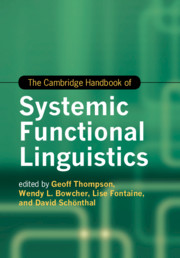Book contents
- The Cambridge Handbook of Systemic Functional Linguistics
- Cambridge Handbooks in Language and Linguistics
- The Cambridge Handbook of Systemic Functional Linguistics
- Copyright page
- Dedication
- Contents
- Figures
- Tables
- Contributors
- Preface
- Acknowledgements
- Introduction
- Part I SFL: The Model
- Part II Discourse Analysis within SFL
- 11 Models of Discourse in Systemic Functional Linguistics
- 12 Cohesion and Conjunction
- 13 Semantic Networks
- 14 Discourse Semantics
- 15 Appraisal
- 16 SFL and Diachronic Studies
- 17 SFL and Multimodal Discourse Analysis
- 18 SFL and Critical Discourse Analysis
- Part III SFL in Application
- Index
- References
11 - Models of Discourse in Systemic Functional Linguistics
from Part II - Discourse Analysis within SFL
Published online by Cambridge University Press: 03 May 2019
- The Cambridge Handbook of Systemic Functional Linguistics
- Cambridge Handbooks in Language and Linguistics
- The Cambridge Handbook of Systemic Functional Linguistics
- Copyright page
- Dedication
- Contents
- Figures
- Tables
- Contributors
- Preface
- Acknowledgements
- Introduction
- Part I SFL: The Model
- Part II Discourse Analysis within SFL
- 11 Models of Discourse in Systemic Functional Linguistics
- 12 Cohesion and Conjunction
- 13 Semantic Networks
- 14 Discourse Semantics
- 15 Appraisal
- 16 SFL and Diachronic Studies
- 17 SFL and Multimodal Discourse Analysis
- 18 SFL and Critical Discourse Analysis
- Part III SFL in Application
- Index
- References
Summary
- Type
- Chapter
- Information
- The Cambridge Handbook of Systemic Functional Linguistics , pp. 285 - 310Publisher: Cambridge University PressPrint publication year: 2019



